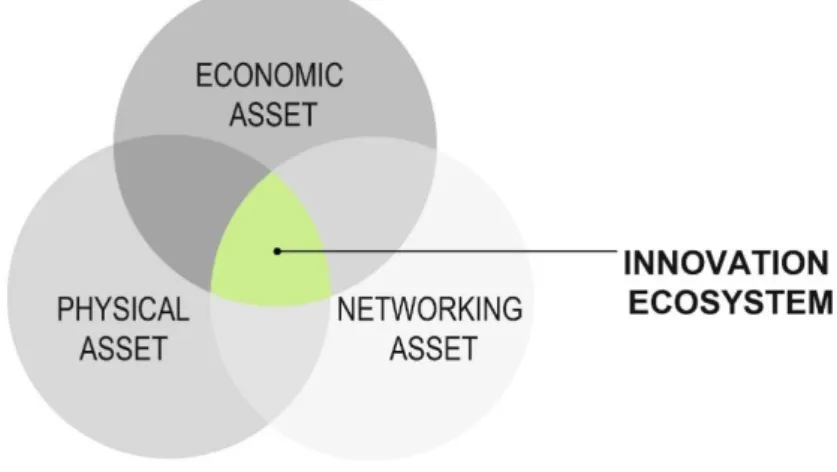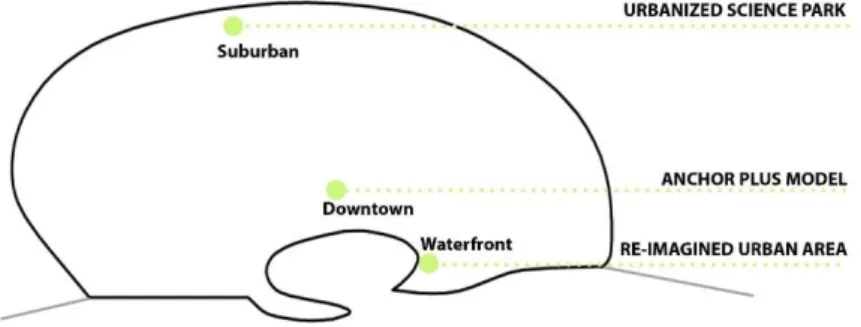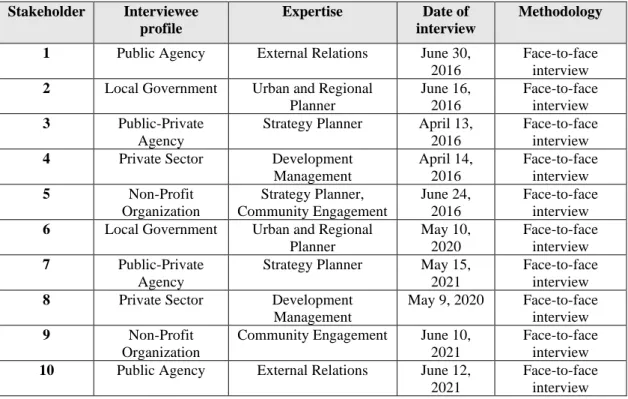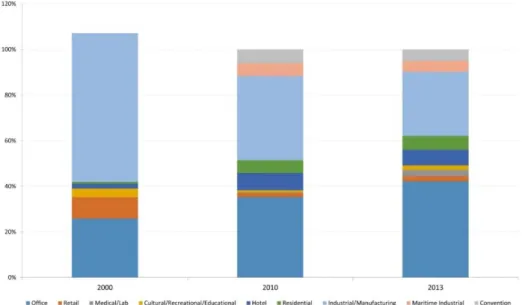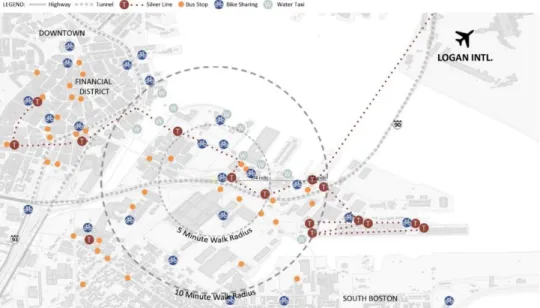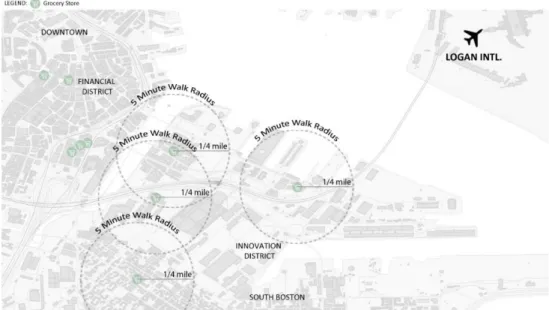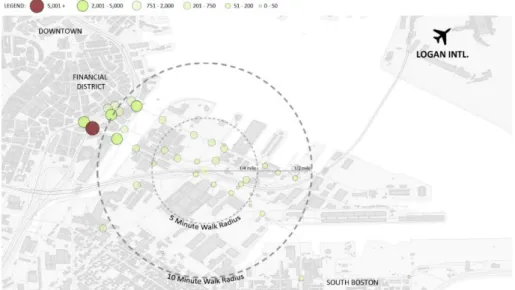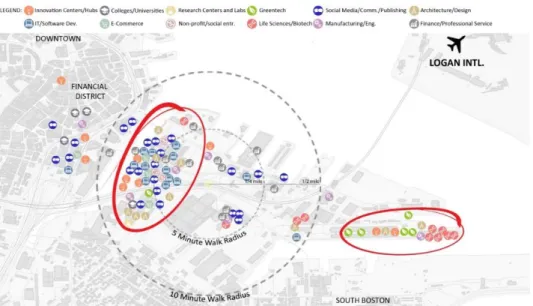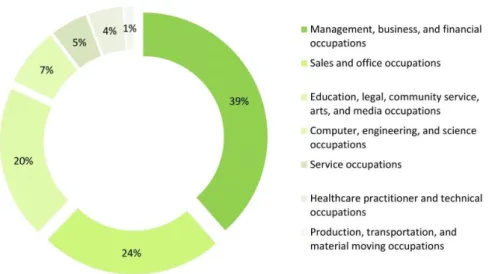ISSN 2502-6429 online © 2020 ITB Institute for Research and Community Services
The Hubs of Transformation Dictated by the Innovation Wave: Boston as a Case Study.
Exploring How Design is Emerging as an Essential Feature in the Process of
‘Laboratorization of Cities’
Luana Parisi
1* and Sohrab Donyavi
1[Received: 27 March 2023; 1st revision: 18 October 2023; accepted in final version: 26 October 2023]
Abstract. Cities have become nodes of global networks, standing at the intersection points of the flows of capital, goods, workers, businesses, and travelers, making them spots where innovation, progress and economic development occur. Design emerges as an essential feature in this process, which this manuscript defines as the ‘laboratorization of cities’, a cutting-edge urban development paradigm that emphasizes cities as dynamic laboratories for innovation and experimentation. This study explored the spatial hubs of transformation within the knowledge economy, providing an overview of the current models of innovation spaces before focusing on the innovation district of one of the cities that are riding the innovation wave, namely Boston, USA. Information was gathered from observations, exploratory interviews with key stakeholders, and on-desk data. The study has significant implications, spanning from informing global urban development strategies to impacting regional economic planning and national policies. It provides valuable insights into how design, innovation, and urban development are interconnected, potentially reshaping how cities and regions approach their growth in the current knowledge-driven era. Useful lessons can be drawn from the case study analysis, allowing to define valuable tools for policymakers, a forward-looking perspective on the future of the laboratorization of cities and the evolving role of design, providing a roadmap for cities aiming to position themselves as global innovation hubs.
Keywords. economic development, innovation district, innovation ecosystem, urban regeneration.
Abstrak. Kota-kota telah menjadi simpul jaringan global, berdiri di titik-titik persimpangan arus modal, barang, pekerja, bisnis, dan pelancong, menjadikannya tempat di mana inovasi, kemajuan, dan pembangunan ekonomi terjadi. Desain muncul sebagai fitur penting dalam proses ini, yang dalam naskah ini didefinisikan sebagai 'laboratorisasi kota', sebuah paradigma pembangunan kota mutakhir yang menekankan kota sebagai laboratorium dinamis untuk inovasi dan eksperimen.
Studi ini mengeksplorasi pusat-pusat transformasi spasial dalam ekonomi pengetahuan, memberikan gambaran umum tentang model-model ruang inovasi yang ada saat ini sebelum berfokus pada distrik inovasi di salah satu kota yang sedang mengalami gelombang inovasi, yaitu Boston, Amerika Serikat. Informasi dikumpulkan dari observasi, wawancara eksplorasi dengan pemangku kepentingan utama, dan data di lapangan. Studi ini memiliki implikasi yang signifikan, mulai dari menginformasikan strategi pembangunan perkotaan global hingga berdampak pada perencanaan ekonomi regional dan kebijakan nasional. Studi ini memberikan wawasan berharga tentang bagaimana desain, inovasi, dan pembangunan perkotaan saling berhubungan, yang berpotensi membentuk kembali bagaimana kota dan wilayah melakukan pendekatan terhadap
1 ACE Department, University of East London, London, UK, (*Corresponding author: [email protected]).
pertumbuhan mereka di era yang didorong oleh pengetahuan saat ini. Pelajaran yang berguna dapat diambil dari analisis studi kasus, yang memungkinkan untuk menentukan alat yang berharga bagi para pembuat kebijakan, perspektif berwawasan ke depan tentang masa depan laboratoriumisasi kota dan peran desain yang terus berkembang, memberikan peta jalan bagi kota-kota yang bertujuan untuk memposisikan diri mereka sebagai pusat inovasi global.
Kata kunci. distrik inovasi, ekosistem inovasi, pembangunan ekonomi, regenerasi perkotaan Introduction
Cities are the preferred places for cultural production and interactions (Montalto, 2013) with their ability to agglomerate highly skilled workers and talented people, and host services and knowledge infrastructures, such as universities and research centers (Dovey et al., 2016), connected through formal and informal relations (OECD, 1996). They participate with success in the knowledge economy as key drivers of productive processes (Gershuny & Miles, 1983; Rullani, 2008) by becoming creative and setting up ecosystems able to attract talents and allow knowledge flows (Montalto, V., 2014). The knowledge economy is increasingly reliant upon intellectual abilities (Powell, Walter & Kaisa Snellman, 2004) of people belonging to the so-called creative class (Florida, R., 2004), where cities assume the role of hubs (Barabási & Albert, 1999), polarizing both physical connections, including ‘passenger travel’ and ‘trade of goods’, and non-physical relations unlocked by ICT (Derudder & Witlox, 2016).
Innovation is triggered as a consequence of these flows, emerging as the driving element of competitiveness, growth, and occupation (Cantafio & Parisi, 2021). From studying the physical spaces and their attributes that foster creativity (Landry, 2011) to the economy of culture, from the
‘creative class’ (Florida, 2002) to the ‘culture-led regeneration’ of big projects, or small urban neighborhoods (Evans, 2009), several scholars have dealt with the topic of innovation within the urban space, starting from knowledge and creativity (Drucker, 1998; Bell, 1999). The emerging primary challenge for them is to enable and support ecosystems that enhance knowledge flows and innovation activities. Thus, a sort of urbanization of innovation is occurring, shifting from
‘suburban corridors and science parks to inner-city areas’ in order to take advantage of the ‘close connectivity among people’ (Parisi & Biancuzzo, 2021). This is a paradigm shift requiring a global outlook and specific local actions, where human capital emerges as the best productive asset, as highlighted first by Marshall (1890) and later by Jacobs (1969), who stressed the importance of having diverse low-cost areas for the first stages of firms to boost innovation.
Taking this framework as a starting point, the urban level was the object of this study, which addressed the explanatory question of how transformations dictated by innovation occur in the context of the knowledge economy. Crucial physical characteristics of innovation districts were identified accordingly. Information was gathered from observations, exploratory interviews with key stakeholders, and on-desk data, which allowed to outline the main features and factors of success of the mentioned spaces of innovation. The purpose of this study was to explore the spatial hubs of transformation within the knowledge economy and to understand their impact on the whole ecosystem of innovation. This paper introduces and defines the concept of ‘laboratorization of cities’, a cutting-edge urban development paradigm that emphasizes cities as dynamic laboratories for innovation and experimentation.
An in-depth analysis of Boston, a prominent global city at the forefront of the innovation wave, is provided as a case study to illustrate the principles of this process of laboratorization of cities. The study took an interdisciplinary approach by drawing from urban planning, architecture, innovation studies, and social sciences to offer a comprehensive understanding of the complex processes at
play in city transformation and discuss policy implications for urban planners, policymakers, and city stakeholders, offering insight into how cities can harness the power of design to drive innovation, economic growth, and sustainable development.
The results of this study may shed light on global urbanization trends, emphasizing the importance of creative and innovative urban design in addressing the challenges posed by rapid urbanization, such as population growth and resource management. The study’s implications range from informing international urban development strategies to influencing regional economic planning and national policies. Its insights into the relationship between design, innovation, and urban development can have far-reaching consequences for how cities and regions approach their development in an increasingly knowledge-driven world. Useful lessons can be drawn from the case study analysis, allowing to define valuable tools for policymakers in the form of a range of factors that define a broad strategy that is able to implement the model successfully. Finally, the work offers a forward-looking perspective on the future of the laboratorization of cities and the evolving role of design, providing a roadmap for cities aiming to position themselves as global innovation hubs.
Literature review
Cities as experimental laboratories
Cities today present economies of density and interactions and try to balance economy, technology, society, and culture (Marin, 2015). They are acting as blenders, creating ‘a built environment that promotes connectivity and collaboration’ based on ‘networking assets’ (Mohl, 2016), becoming theatres to improve the economy, working on all the possible existing resources (Marin, 2015).
The focus on proximity, defined by the economist Enrico Moretti (2012) as a thick labor market, is expressed by the match between employers and employees and is mainly due to the fact that
‘ideas need a tight ecosystem that fosters creative growth’ (Cairncross, 2001). Thus, geographical proximity is a ‘prerequisite to make learning and innovation successful’ (Butzin & Widmaier, 2012). Innovation goes hand in hand with density, which allows the sharing of ideas and collaborations. Thus, some urban centers are becoming rich and complex spaces consisting of intricate interrelationships, which raises the issue of ‘chosen space’, i.e., where people want to work (Pais, 2013). If, before, social capital was the output of companies and organizations, today, proximity and the interrelations between people are precise inputs and goals of companies. The shift has been from digital relations to physical spaces. The social interactions within these spaces benefit innovation, productivity, and territorial development, improving the social innovation aspect (Pais, 2013). Design emerges as an essential feature in this process of ‘laboratorization of cities’, a fulcrum that allows cities to develop prosperously by creating new spaces and welcoming open innovation through density and proximity (Katz & Wagner, 2014).
Accordingly, many cities worldwide have moved from their industrial past to become knowledge cities, adopting strategies able to trigger innovation and let local economies thrive. It is a paradigm defined as ‘knowledge-based urban development’ (KBUD) (Esmaeilpoorarabi et al., 2020), which leverages specific new physical spaces, including ‘innovation districts’ (American Institute of Architects, 2013), designed as the main setting of knowledge-based dynamics (Yigitcanlar &
Lönnqvist, 2013) and innovation.
The KBUD approach intends to catalyze economic success, sustainable environments, governance, socio-spatial order in city hubs, where the production and flow of knowledge is boosted, resulting in knowledge cities (Yigitcanlar & Bulu, 2016; Bulu, 2014; Yigitcanlar, 2014). As a matter of fact,
the highest specialization rates in knowledge-intensive services are found in large urban areas, which also exhibit the highest levels of innovation (Capello et al., 2012). The focus is not only on the creation of knowledge cities but also on the development of the geography of innovation (Yigitcanlar & Bulu, 2015).
The concept of innovation serves as a fundamental element in all conversations revolving around urban management. The research and innovation segment of cities is considered a pivotal aspect of urban marketing, acting as a key driver of economic growth (Bevilacqua, Parisi & Biancuzzo, 2018;
Bevilacqua, Cantafio, Parisi, & Pronestì, 2018; Vesalon & Creţan, 2019). Complex economic and political issues are thought to be solved as well by these spaces of knowledge and innovation, making them a panacea for different issues, including unemployment and regional industry issues (Yigitcanlar et al., 2015). This explains why urban planners look at them as valuable tools to encourage city development strategies and economic growth (Fikirkoca & Saritas, 2012).
The Innovation District model
The above-mentioned spaces of innovation are believed to be a crucial factor of the knowledge economy, especially innovation districts (Esmaeilpoorarabi et al., 2020; Etzkowitz & Leydesdorff, 2000). Therefore, it is necessary to study all their development processes to obtain a holistic vision of their design and mechanisms. The model of innovation districts, as theorized by Katz & Wagner (2014) is changing the industrial landscape, proposing the necessary mix of innovative companies, incubators, co-working spaces, public spaces, and experimental residences for the whole community and not just for knowledge workers (Davenport, 2005), giving new shapes to the relations between public and private lives.
These areas catalyze anchor institutions, clusters of companies, incubators, start-ups, accelerators, in an environment able to boost open collaboration through compact, mixed-use neighborhoods, accommodating ‘live-work-play’ activities within a walking distance, in underutilized or distressed areas close to city cores (Katz, B., & Wagner, 2014). They have been implemented since 2000 as place-based policies aimed at regenerating entire portions of city centers while promoting innovation and triggering knowledge economies (Katz & Wagner, 2014; Morisson, 2014). Based on the theories of agglomeration (Duranton and Puga, 2001; Jacobs, 1969; Marshall, 1890; Porter, 1990), these models leverage the aggregation of talented people in specific quarters and their exchange of ideas and information dynamically spurring processes of innovation (Hall, 2003). They are seen as important models for boosting innovation, urban regeneration (Drucker et al., 2019), human capital potential, and economic growth, also by putting capital investments into the weakest neighborhoods (Kayanan, 2021) leveraging three main assets: economic (innovation drivers, neighborhood-building amenities…), physical (synergic public and private spaces), and networking, which create an innovation ecosystem at their intersection (Figure 1) that mingles education, housing, entertainment and commercial facilities with working amenities (Katz &
Wagner, 2014; Kayanan, 2021).
The innovation district model is built on these existing policy tools (Kayanan, 2021). Public- private partnerships as leading development models (Parisi & Biancuzzo, 2021; Sagalyn, 2007) together with tax relief programs stand at the core of the financing mechanisms of these spaces of innovation (Weber, 2002).
There are three main typologies in the model, namely, ‘anchor-plus’ (based on a mixed-use redevelopment of a downtown or midtown area, focused on a leading institution in a central city),
‘re-imagined urban area’ (located in former industrial areas, infrastructured, along waterfronts and
close to the downtown of a city) and ‘urbanized science park’ (the transformation of isolated suburban or exurban areas) (Figure 2) (Katz & Wagner, 2014).
Figure 1. The innovation ecosystem output. Source: retrieved and adapted by the authors from Katz, B., & Wagner, J. (2014).
Figure 2.Typologies of innovation districts. Source: retrieved and adapted by the authors from Katz & Wagner (2014)
This urban model contrasts with the one that dominated the past fifty years and more, which was based on the landscape of innovation typical for Silicon Valley, made up of suburban corridors, close to isolated campuses, often car-oriented, without the necessary mixed-use approach. It is a landscape that is changing at a quick rate (Kreutz, 2016), aimed mainly at potentiating urban economies, transforming cities in laboratories for boosting changes and innovation. They facilitate knowledge spillover and exchange of ideas among the community of innovators (O’Sullivan, 2012) and can be promoted by different actors, focusing on a neighborhood, a group of people, or a targeted portion of the city. Companies, research centers, start-ups, public and private actors, and universities can share their know-how thanks to the creation of the above-mentioned ‘third places’
(Oldenburg, 1989) in a sort of ‘third industrial revolution’ (Rifkin, 2011). The direct consequences of this ‘choreography of collisions’ (Scola, 2014) regard the democratization of production and the reshoring phenomenon. Thus, the local is better projected into the global and makes cities more attractive, where small and medium enterprises are the most inclined towards these new tendencies (Cantafio & Parisi, 2021; Donyavi et al., 2022; Marin, 2015; Donyavi et al., 2023a; Donyavi et al., 2023b).
At the same time, though, criticism regarding the potential risk of gentrification, displacement, spatial isolation, and housing unaffordability have been raised by some scholars (Zandiatashbar &
Kayanan, 2020). This is paired with some critiques revolving around the view of innovation districts as tools for neoliberal urban economic development, as key stakeholders, including urban planners and municipal authorities, embrace them to boost economic growth in reaction to the construction downturn caused by the global financial crisis (Kayanan, 2021). Recent works have already started to acknowledge these critiques, including the book by Richard Florida that shows how the same forces that boosted the ‘back-to-the-city’ movement have generated some challenges that leave many cities stagnating. Thus, the superstar cities are just a demonstration of a deep crisis in the newest urbanized knowledge economy (Florida, 2017).
Methodology
Information for the purpose of this manuscript was gathered from observations, exploratory interviews with key stakeholders, and on-desk data. At the outset, the intention was to conduct a longitudinal investigation in order to be able to collect data and information from various stakeholders who are involved in different capacities in the innovation space in Boston, representing the chosen case study. Five stakeholders were selected by adopting the purposeful sampling technique, as respondents play a prominent role in relation to the selected case study. This allowed to grasp an understanding of the processes on the ground from key actors. Respondents (Table 1) were identified on the basis of their area of work. Specifically, exploratory interviews were undertaken with senior managers, strategic initiative managers, executive directors, and deputy directors working in the greater Boston area.
Table 1. Stakeholder profiles. Source: authors’ elaboration (2022) Stakeholder Interviewee
profile
Expertise Date of interview
Methodology
1 Public Agency External Relations June 30, 2016
Face-to-face interview 2 Local Government Urban and Regional
Planner
June 16, 2016
Face-to-face interview 3 Public-Private
Agency
Strategy Planner April 13, 2016
Face-to-face interview
4 Private Sector Development
Management
April 14, 2016
Face-to-face interview
5 Non-Profit
Organization
Strategy Planner, Community Engagement
June 24, 2016
Face-to-face interview 6 Local Government Urban and Regional
Planner
May 10, 2020
Face-to-face interview 7 Public-Private
Agency
Strategy Planner May 15, 2021
Face-to-face interview
8 Private Sector Development
Management
May 9, 2020 Face-to-face interview
9 Non-Profit
Organization
Community Engagement June 10, 2021
Face-to-face interview 10 Public Agency External Relations June 12,
2021
Face-to-face interview The semi-structured face-to-face interviews were divided into three parts: the first part focused on the physical aspects of innovation spaces, including questions revolving around the role of innovation ecosystems, successful industrial clusters, and the role of anchor institutions; the second
part explored economic growth policies linked to urban regeneration policies and market-driven programs of real estates; and the third part expanded more on specific agendas implemented in the areas of innovation spaces. Findings from site observations and interviews will be presented in the next sections. These will support the elements analyzed in the literature review and highlight new insights.
Case study
Boston’s Innovation District
Being among the largest cities in the United States, Boston has the profile of a city that is growing, with an increase in its foreign-born population (United States Department of Commerce, 2014), which represents a precious source of innovation and economic growth, depending also on the character of Boston as a mecca for education (Parisi & Eger, 2020; public agency representative, personal communication, June 30, 2016).
The year 2008 with the collapse of the market represents a key turning point for the city, especially under the planning regulation lens. The old planning made by the Boston Redevelopment Authority (BRA, now known as Boston Planning & Development Agency) back in the late 1990s has been deeply revised to accommodate the city needs and features, such as the high concentration of young adults (local government representative, personal communication, June 16, 2016). Over the past few years several innovation-oriented policies have been implemented (Table 2) in order to boost territorial growth through urban regeneration processes (Bevilacqua et al., 2017).
Table 2.Innovation-oriented policies implemented in Boston over the past few years. Source:
adapted from Bevilacqua et al. (2017) Geographical
level
Innovation-oriented
policy initiative Main objective Start
Year
City of Boston
LifeTech Boston Foster the growth of Boston’s life sciences and high
technology sectors. 2004
Boston Innovation District
Transform the South Boston waterfront area in an urban environment that fosters innovation, collaboration, and entrepreneurship.
2010
Neighborhood Innovation District
Support neighborhood residents, existing businesses
and start-ups in the creation of innovation. 2014 In 2010, the city of Boston through the BRA pushed to transform the underutilized former industrial area of South Boston called Seaport District, launching the Innovation District initiative (Bevilacqua et al., 2017) with the aim of generating ‘an ecosystem of innovation and entrepreneurship’ (Rodriguez et al., 2015). The intent of the public administration was from the outset to bring people in the former port area and push a mixed neighborhood (non-profit organization representative, personal communication, June 24, 2016) able to spur global competition for companies, new ideas and ways of working, creating new jobs and retaining local talents. The BRA started looking at working spaces similar to laboratories (local government representative, personal communication, May 10, 2020) in order to launch a series of collaborative open spaces and organizations. These included co-working spaces and job training companies able to trigger the necessary sets of skills for the innovation economy (Urban Land Institute, 2014).
The largest undeveloped area in the city started to become a vital microcosm. The physical characteristics of Boston’s waterfront, including its crossroads character, played an important role in selecting the area for a development project to become an economic engine (Hacin + Associates, Inc., 2014). Under the name of innovation, this urban regeneration area developed a place to network (local government representative, personal communication, June 16, 2016) around the District Hall building, viewed as ‘Boston’s First Public Innovation Center’ (Rodriguez et al., 2015).
This has been followed by the provision of flexible spaces, cultural amenities, and new workspaces (Hacin + Associates, Inc., 2014). In terms of land use, the total developed space in 2013 covered about 24 million square feet, with an increase of 73% since 2000 (MassDot, 2015). As illustrated in Figure 3, while the year 2000 the area was dominated for 65% by the industrial and manufacturing sectors, from the year 2000 to the year 2013 there was an increase in office (from 26% to 42%), residential (from 1% to 6%), convention (from 0% to 5%) and hotel (from 2% to 7%) uses, with a decrease in manufacturing, industrial and maritime sections (from 65% to 33%) (Parisi & Eger, 2020; MassDot, 2015). Port activities and industrial uses are still present, occupying about one third of the waterfront land (MassDot, 2015), confirming the fact that innovation districts encourage a balanced mix of land uses (Morisson, 2015) in 24/7 vibrant neighborhoods based on the creation of a ‘live-work-play’ hub (Hacin + Associates, Inc., 2014). In the next paragraphs the district will be analyzed according to these three categories.
Figure 3.Land use comparison. Source: authors’ elaboration (2016), based on the Boston Redevelopment Authority data
Case study results – Data analysis Live
The Seaport District started to shape itself as a neighborhood in 2010 (public agency representative, personal communication, June 12, 2021), attracting progressively more residents at a moderate density (1,231 households per square mile) (Florida & King, 2016) and a relatively high housing occupancy but lower than the city’s average (77% against 92%) (United States Department of Commerce, 2015).
About 60% of the housing units appeared after the year 2000, more than 60% of the householders moved into the units after 2010, and more than 70% of people living in the district were non-family
households (United States Department of Commerce, 2015). The BRA plan included 12,000 new residential units, dedicating up to 15% to workforce housing, using different models, such as co- housing and micro-units with studios (local government representative, personal communication, May 10, 2020), and another 15% to affordable accommodations (Rodriguez et al., 2015). Despite housing projects and other facilities moving forward (Katz & Wagner, 2014), residents have been waiting for basic neighborhood amenities such as grocery stores for a long time (local government representative, personal communication, June 16, 2016; Baker et al., 2012). As shown in Figure 4, half of the area can almost be considered a ‘food desert’ due to the lack of access to major grocery stores and healthy food options (on-field observations; Baker et al. 2012).
Figure 4. Access to grocery stores. Source: authors’ elaboration based on on-field observations, 2016
Figure 5.Transportation system. Source: authors’ elaboration based on data from MBTA, Seaport Transportation Management Association, Hubway, 2016
The district presents the profile of a moderate ‘walkable and transit-friendly’ neighborhood that is improving its performances (Florida & King, 2016). Yet, as pictured in Figure 5, despite the important role played by the transportation system in developing the area (Katz & Wagner, 2014;
Kayanan, 2019), the public transit system is still not adequate for serving the current and forecasted improvement of the area.
The pedestrian volumes in the area vary consistently and both public and private actors aim to see a substantial pedestrian growth in the seaport area and are studying the pedestrian patterns (local government representative, personal communication, June 16, 2016). Figure 6 shows the
pedestrian volume by intersection for peak hours (MassDot, 2015).
Figure 6.Pedestrian volume by intersection for peak hours. Source: authors’ elaboration based on the South Boston Waterfront Sustainable Transportation Plan 2015
Work
A rising number of companies are considering moving to compact areas that are rich in amenities close to city centers, focusing on the possibility to congregate and innovate (Florida, 2014;
Morisson, 2015). The innovation district in Boston is stimulating the economic growth of the whole city system, thus becoming an essential catalyst for new companies. More than 200 firms have been established, creating around 5,000 new jobs (Johnson, 2016; Parisi & Eger, 2020). The ecosystem that has been developed includes workspaces, public spaces, co-working spaces, incubators, and non-profit organizations (non-profit organization representative, personal communication, June 24, 2016), with about 40% of firms in the area sharing spaces (Rodriguez et al., 2015).
Observations and interviews confirmed what was theorized at the beginning of this research, namely, that innovation districts get attached to whole innovation ecosystems (Katz & Wagner, 2014). Figure 7 shows this innovation ecosystem reflecting Mayor Menino’s ‘vision for an industry-agnostic community that collaborates and innovates’, open to all kind of industries of different sizes (Rodriguez et al., 2015). Proximity is the key (Hacin + Associates, Inc., 2014), which is confirmed by the closeness of businesses as the two-minute walk radius fixed in the centroid of the district shows.
Figure 7.The innovation ecosystem’s clusters. Source: authors’ elaboration based on on-field and on-desk data (InnovationDistrict.org), 2016
The strong presence of the financial sector is due to the proximity of the financial district.
Accordingly, office occupations, together with education, legal, community services, arts and media occupations employ 44% of the total workforce (Figure 8). Technology companies ‘have contributed 30% of new job growth’, creative industries 21% and Greentech and Life Sciences, that are growing, brought 16% of the new jobs of the area (cityofboston, 2013).
Figure 8.Employment by sector in the Boston Innovation District. Source: authors’ elaboration based on data from the United States Department of Commerce, 2015
Figure 9. Social assets map. Source: authors’ elaboration based on on-desk data (GoogleMaps, BRA), 2016
Play
The area is active not only because it is full of innovation spaces but also coffee shops, restaurants and bars, intended especially for allowing the community of innovators to interact (non-profit organization representative, personal communication, June 10, 2021; private sector representative, personal communication, April 14, 2016), trying to reproduce the ecosystem of innovation found in other areas of Boston such as Kendall Square (private sector representative, personal communication, May 9, 2020). Thus, the winning model is the one using a social approach for spurring innovation (public-private agency representatives, personal communication, May 15, 2021). Figure 9 shows the social assets of the district, where companies function like restaurants and, according to game theory, these work better if they are close to each other (Brickley, Smith &
Zimmerman, 2000; public-private agency representatives, personal communication, April 13, 2016).
Figure 10 illustrates a Play Map, including the main cultural anchors of the area, together with art galleries and laboratories, green spaces, and visitor attractions.
Proximity and culture are playing a major role in this development, connecting and inspiring communities (Hacin + Associates, Inc., 2014). Further discussion and interpretation of the above information will be deepened in the next section.
Figure 10.Play map. Source: authors’ elaboration based on on-field research and on-desk data, 2016
Discussion
What emerged from the previous analysis is the importance of public involvement for the success of the innovation district policy. The innovation district demonstrates that cities “are better positioned than state and federal agencies to find new ways to collaborate to implement public services”. The Boston Innovation District is managed by the main public planning agency (BRA), which partially funds the project and, through public-private partnerships with corporations, helps to “ease the financial burden of the project on the city’s budget” (NLC, 2015).
The public sector acted as the main operator guaranteeing the economic development of the context, also through the attraction of private investments, the creation of jobs, and the provision of the necessary services (Britto, 2015). In doing so, it used some development tools that are considered more traditional, such as zoning regulations, which have been changed to accommodate innovation (local government representative, personal communication, June 16, 2016), “the development of physical infrastructure” and tax relief programs (Britto, 2015), such as the Tax Increment Financing (TIF) approved in the year 2011. Thanks to the latter real estate taxes (Rodriguez et al., 2015), it has been possible to attract businesses in the area and increase tax revenues to fund specific public projects (Britto, 2015). Furthermore, some parts of the district are included in a Foreign Trade Zone (FTZ), eliminating duties, and allowing the manufacturing of products using domestic or foreign parts (massport.com).
The city of Boston leading the project, engendered a sort of identification between the district and the city, allowing the neighborhood to “develop organically” (Rodriguez et al., 2015) following market forces (Britto, 2015) and creating momentum for spreading innovation throughout the city (Rodriguez et al., 2015).
The innovation district in Boston, then, is the demonstration of a clear public intention to regenerate the area. The ‘spatial matrix’ created, resulted in a dynamic living laboratory, implementing built- environment goals. The ‘public entrepreneurship approach’ facilitated this process, making it more efficient in unlocking robust partnerships and synergies with non-profit organizations and the private sector (Bevilacqua, Parisi & Biancuzzo, 2018). It also created the specific intention to
develop social infrastructures and build a community able to meet the needs of all different actors that play a role in the district (Britto, 2015; non-profit organization representative, personal communication, June 24, 2016). This explains why the district leverages the educational aspect for spurring innovation, while also strengthening the sense of community. This interaction with educational institutions allows to have a pool of talented people that mingle with businesses.
Another aspect that has been triggered from the outset regards the aim to provide an adequate cultural framework. It emerges that the innovation district works better if it gets attached to an existing prepared ecosystem, and an anchor institution is essential to shape the community of innovators (Bevilacqua, Parisi & Biancuzzo, 2018).
The main factors of success that can be extrapolated from the case study analysis are summarized below (Figure 11).
Figure 11.Factors of success. Source: Authors’ elaboration, 2016
Accordingly, it is suggested to have a broad strategy to implement the model, representing the implications for tailoring successful innovation district policies. It comes from the hierarchization of the above outlined factors of success (Figure 12).
The outermost circle represents the general framework, including the necessity of a place-based approach, strengthening the specificities of the place and of a consistent role of the city. Being a long-term strategy, clusters of businesses within innovation districts take time to grow, meaning that strong public support together with political and economic stability is necessary. The second circle includes tools and physical characteristics. As a matter of fact, under the public initiative umbrella, there are public-private partnerships and a tax incentive system. Under the other umbrella, referring to the place-based necessity, the availability of spaces, having declined due to the revitalization of under-used parts of the city, and the pre-existence of facilities make the interventions more feasible. The third circle includes the prerogatives of the interventions, namely the educational aspect and the cultural framework. The educational framework of a place adds the necessary intellectual capital to the model. At the core of the intervention there is social activation together with community engagement, knowledge sharing processes, and social interactions.
This paper’s policy implications extend far beyond the confines of Boston. Its insights are poised to inform international urban development strategies, influence regional economic planning, and shape national policies. By elucidating the intricate relationship between design, innovation, and urban development, it empowers cities and regions to navigate the challenges of a knowledge- driven world effectively.
Figure 12.Broad strategy for tailoring successful policies. Source: Authors’ elaboration, 2016 Conclusions
The purpose of this study was to explore the spatial hubs of transformation within the knowledge economy, understanding their performance within the whole ecosystem of innovation. For this reason, the role of cities within the knowledge economy was investigated, as they are, based on the literature, the physical hubs where innovation, progress and economic development occur (Hall & Pfeiffer, 2002). One of the main initial assumptions was that the new economic geography is based mainly on highly specialized professional activities, geographically concentrated in urban contexts (Sassen, 2011).
The explored literature suggests that design can facilitate these processes by creating spatial, compact hubs, often close to the city center. These innovation spaces emerge as contemporary industrial districts, leveraging the importance of being in clusters, using the proximity principle to trigger innovation. Herein, for the first time, this process is called ‘laboratorization of cities’
and it was documented how it is connected with the ad-hoc evolving role of design, providing a roadmap for cities aiming to position themselves as global innovation hubs.
This study was based on a single case-study approach, which made it clear that the development trajectories of innovation spaces are founded on the belief that cities can provide the necessary hummus for developing strategies able to get the most out of both urbanization and the knowledge workforce. Density emerges as the main ingredient for spurring an open concept of innovation, minimizing risks and creating ecosystems that have the potential to turn into
economic engines. The concept of density can be adapted to the dimensions of time and space as well, to provide knowledge workers with a seamless milieu to spend as much time as possible in the enclosed bubble of the innovation district.
In line with the explored literature, the study confirmed that the development of the knowledge economy is enabled by different factors blended together. The successful ones, which defined a broad strategy that was able to implement innovation spaces, confirmed that the place features matter the most to achieve competitiveness and socioeconomic positive outputs. What emerged from the case study in Boston is that the provision of a new governance was necessary for its innovation district. Strong public-private partnerships encouraged the development of new initiatives and several non-profit organizations financed local start-ups.
City officials and agencies played a crucial role in determining the city’s innovation priorities and strategies, showing a significant power in shaping the direction of innovation by influencing policies related to zoning, land use, and economic development, which in turn affected the distribution of resources and opportunities. Developers and property owners’ decisions regarding where to invest in development projects then impacted the physical landscape of the city, leading to changes in informal areas.
Large tech companies, start-ups, and research institutions had a substantial influence on the local economy and job market. They shaped the demand for talent, impacted property values, and contributed to the transformation of entire neighborhoods. Innovation then led to job creation and economic opportunities, benefiting some residents in informal areas. For example, local tech training programs or community initiatives helped to bridge the digital divide and provide valuable skills to underserved communities.
On the other side, though, the influx of highly skilled professionals and tech companies drove up property values, making it harder for residents in informal areas to afford housing. This resulted in displacement and increased socio-economic inequality. In essence, the impact of innovation on informal areas in Boston, as in many other cities, discloses itself as a complex process that can be shaped by various power relations and socio-economic factors. Policymakers and community leaders often grapple with the challenge of ensuring that innovation benefits all residents and mitigates the negative consequences of rapid urban development.
This research emphasizes that innovation spaces seem to be going through a new phase, which is mainly about big corporations acquiring entire portions of cities and start-up companies and emerging businesses needing incubation (Sassen, 2015). Over time, it has become more about the expansion of the city itself (Mohl, 2016), spurring an infill development within the urban system. The innovation district model emerged as a stretching exercise of the city, with the potential to boost the desired vibrant and dynamic environment able to attract even more investments and talent workforce. This way, the entire city could potentially become a stage for the knowledge economy.
Winners of this process certainly are highly skilled professionals, such as tech experts, researchers and innovators, entrepreneurs and startups that can easily access funding, mentorship, and networking opportunities, real estate developers, since as the city grows and attracts talent and businesses, property values tend to increase; universities and research institutions thrive in innovative cities, as they attract talent, funding, collaborations, and finally large technology companies, which often establish a presence in innovative cities to tap into the local talent pool and stay at the forefront of innovation.
At the same time, as previously highlighted, the ‘back-to-the-city’ movement generated some challenges within what can be deemed to be a deep crisis in the newest urbanized knowledge economy (Florida, 2017). A crisis that leaves some losers behind, including low-skilled workers who may face limited job prospects and lower wages, contributing to income inequality; long- time residents, as gentrification and rising property values can displace them, leading to community fragmentation and social tensions; small businesses, since, while some startups thrive, small businesses without a competitive edge in the knowledge economy may struggle to survive in the face of competition from larger, tech-oriented companies. Additionally, vulnerable populations may face increased challenges, as rising costs and limited access to affordable housing and services can exacerbate social inequality. Cities that transition to a knowledge-based economy may see a decline in traditional industries like manufacturing and agriculture, as can be seen in Figure 3 (land use comparison for the city of Boston), potentially leading to job losses and economic disruption in these sectors. In essence, the impact of innovation in cities like Boston is quite complex and multifaceted, and policymakers often strive to address these challenges and ensure that the benefits of innovation are more equitably distributed among city residents.
International, regional, and national implications of this study
The findings of this study can serve as a valuable reference for urban planners, policymakers, and researchers in cities around the world. Understanding how design and innovation intersect in urban development can inform strategies for fostering innovation hubs globally. The study may shed light on global urbanization trends, emphasizing the importance of creative and innovative urban design in addressing the challenges posed by rapid urbanization, such as population growth and resource management. The research may also contribute to discussions on urban competitiveness and the role of design in enhancing the attractiveness and competitiveness of cities on the global stage. It provides insight into how cities can position themselves as innovation leaders.
At the regional level, this study can inform economic development agencies and regional planners about the potential benefits of fostering innovation districts and the role of design in this process. This knowledge can be applied to stimulate economic growth and job creation. The case study of Boston can be used for comparisons with other regional cities. It can help neighboring cities understand how Boston’s innovation ecosystem evolved and identify potential strategies for their own development. Regions with multiple cities can explore collaborative initiatives to create innovation ecosystems. This study can encourage regional cooperation and the sharing of best practices in fostering innovation hubs, as can be seen in federal urban development policies and funding allocation. Also, it can inform discussions on how federal agencies can support cities in fostering innovation, potentially leading to the allocation of resources for urban innovation initiatives.
National education and research institutions can benefit from our insights into the role of universities and research centers in driving innovation. This could lead to discussions about supporting higher education as a driver of regional and national innovation. At the national level, the research can contribute to discussions on enhancing the economic competitiveness of the United States. It can inform strategies for leveraging design and innovation to stimulate economic growth and global competitiveness.
Implications for emerging economies
Emerging economies can glean valuable lessons from the case study explored in this work as well.
Boston’s success in innovation is closely tied to its world-renowned universities and research centers. Emerging economies can learn the importance of investing in higher education and research institutions as drivers of innovation. Establishing strong academic institutions can in fact attract talent, foster research, and incubate innovation.
Boston’s innovation ecosystem thrives on collaboration between academia, industry, and government. This means that emerging economies can encourage partnerships and collaborations between these sectors to create an environment where ideas can flourish, and innovations can be commercialized effectively. Boston’s support for startups and entrepreneurship has been pivotal in its innovation journey. Emerging economies can establish startup incubators, accelerators, and access to venture capital to nurture and grow new businesses. A supportive ecosystem for entrepreneurs can stimulate innovation.
The study emphasizes the role of design in shaping innovation districts. Emerging economies can prioritize urban planning that encourages mixed-use spaces, green infrastructure, and creative environments that facilitate knowledge exchange and innovation. Boston’s success is partly attributed to government policies that encourage innovation. These policies can be studied to create a conducive regulatory environment, offer tax incentives for research and development, and provide grants for innovative projects. Based on this case study, emerging economies should also invest in modern infrastructure to support the growth of innovation hubs. They can work on cultivating a culture that is open to experimentation and learning from failures rather than penalizing them. They can further learn the importance of fostering international linkages and attracting a diverse pool of talent to fuel innovation. Learning from Boston’s experiences, emerging economies can proactively implement policies that protect vulnerable populations, preserve affordable housing, and ensure that the benefits of innovation are distributed more equitably.
Recommendations for future studies and this study’s limitations
Future research should focus on the contribution of these spaces to the whole city life and on the mutual economic benefits that could be triggered as an effect. The exploratory character of this contribution also implies other limitations, reflected mainly in the methodological aspect. In particular, it should be highlighted that a limited number of observations and interviews makes the results modestly significant from a statistical point of view. Thus, for future research it would be more valuable to broaden the adopted sample for the interviews and increase the number of observations. Moreover, it would be valuable to deepen even more the climate for growth that is necessary for spurring the innovation spaces in the knowledge economy. Regarding the local economic development framework, it would have been useful to expand on the external economic forces that influence it. Moreover, regarding the highlighted success factors of innovation districts, it should be specified that these elements emerged as being place-specific, which makes it difficult to generalize them.
Acknowledgements
This contribution was developed also thanks to the research experience at the Northeastern University, part of the research project MAPS-LED (Multidisciplinary Approach to Plan Smart Specialization Strategies for Local Economic Development), which received funding from the European Union’s Horizon 2020 research and the innovation program under a Marie Skłodowska-
Curie grant (agreement number 645651). Finally, the authors want to thank the people closest to them, who always give their priceless support.
Disclosure statement
Conflicts of interest: none.
References
Akinci, G., & Crittle, J. (2008). Special economic zones: Performance, lessons learned, and implications for zone development. Washington DC: The World Bank, E3.
American Institute of Architects. (2013). Cities as a Lab: designing the innovation economy.
Baker, M. R., Vogel, C., & Doyle, P. (2012, July). The Rise of the Seaport. Retrieved 2016, from bostonmagazine: http://www.bostonmagazine.com/2012/07/rise-seaport-district-boston/.
Barabási, A. L., & Albert, R. (1999). Emergence of scaling in random networks. science, 286(5439), 509-512.
Bell, D. (1999). The Coming of Post-Industrial Society. New York: Basic Books. pp. x–xi, xiv, xv–
xvii.
Bevilacqua, C., Borrello, V., Maione, C., Parisi, L. (2017). ‘The Urban Dimension of Innovation Policy: Roxbury Innovation Centre.’ In 13th Int'l Postgraduate Research Conference, University of Salford, Conference Proceedings 14-15 Sept 2017, pp. 1040-1053.
Bevilacqua, C., Parisi, L., Biancuzzo, L. (2018). ‘Multi-stage strategic approach in spatial innovation: how innovation district matter?’ Book series ‘Smart Innovation, System and Technologies’ (2190-3018) by SPRINGER.
Bevilacqua, C., Cantafio, G. U., Parisi, L., & Pronestì, G. (2018). Investigating local economic trendsfor shaping supportive tools to manage economic development: San Diego as a case study.
InInternational Symposium on New Metropolitan Perspectives (pp. 191-200).
Springer.https://doi.org/10.1007/978-3-319-92099-3_23.
Boston Planning & Development Agency (n.d.). South Boston Waterfront. Retrieved 2016, from bostonplans: http://www.bostonplans.org/neighborhoods/south-boston-waterfront/at-a-glance.
Brickley, J., Smith, C., & Zimmerman, J. (2000). An introduction to game theory and business strategy. Journal of Applied Corporate Finance, 13(2), 84-98.
Britto, N. (2015, December 17). The Evolving Roles of Local Government: Insights from Boston’s Innovation District. Retrieved January 13, 2017, from livingcities:
https://www.livingcities.org/blog/1006-the-evolving-roles-of-local-government-insights-from- boston-s-innovation-district.
Bulu, M. (2014). ‘Upgrading a City via Technology’, Technological Forecasting and Social Change 89 63-67.
Butzin, A., & Widmaier, B. (2012). The study of time-space dynamics of knowledge with innovation biographies (No. 07.12). Working Papers on Innovation and Space.
Cairncross, F. (2001). The death of distance: How the communications revolution is changing our lives. Harvard Business Press.
Cantafio, G. & Parisi, L. (2021) ‘Micro-Wineries as drivers for local economic development and innovation in lagging areas’. Wine Economics and Policy 10(1): 23-32. doi: 10.36253/wep- 8194.
Capello, R., Caragliu, A. and Lenzi, C. (2012). ‘Is innovation in cities a matter of knowledge- intensive services? An empirical investigation,’ Innovation: The European Journal of Social Science Research, vol. 25, no. 2, pp. 151–174.
City of Boston. (2013, March 01). Mayor Menino Releases Results of Innovation District Jobs
Report. Retrieved 2016, from cityofboston:
http://www.cityofboston.gov/news/Default.aspx?id=6008.
Davenport, S. (2005). Exploring the role of proximity in SME knowledge-acquisition. Research policy, 34(5), 683-701.
Derudder, B., & Witlox, F. (2016). Hub cities in the knowledge economy: seaports, airports, brainports. Routledge.
Donyavi, S., Parisi, L. & Flanagan, R. (2022) ‘The paradigm shift needed by Micro, Small and Medium sized enterprises to operate in the international construction market’. Proceedings of the International Conference on the Leadership and Management of Projects in the digital age (IC:LAMP 2022) - ISBN: 978-99958-0-808-2, Kingdom of Bahrain, 27 - 28 November 2022.
Donyavi, S., Flanagan, R., Assadi-Langroudi, A., & Parisi, L. (2023a). Optimising the use of Materials for Construction MSMEs: Building a Comprehensive Framework for Decision- Making and Resource Allocation through an Analytic Hierarchy Process. International Journal of Construction Supply Chain Management, 13(1), 50-74.
Donyavi, S., Flanagan, R., & Parisi, L. (2023b). Understanding the complexity of materials procurement in construction projects to build a conceptual framework influencing supply chain management of MSMEs. International Journal of Construction Management, DOI:
10.1080/15623599.2023.2267862.
Doron, G.M. (2000) The dead zone and the architecture of transgression. City 4(2): 247–263.
Dovey, J., Pratt, A. C., Moreton, S., Virani, T., Merkel, J. & Lansdowne, J. (2016). The Creative Hubs Report 2016. Creative Hubs: Understanding the New Economy. City University of London.
Drucker, J. M., Kayanan, C. M., & Renski, H. C. (2019). Innovation Districts as a Strategy for Urban Economic Development: A Comparison of Four Cases. Available at SSRN 3498319.
Drucker, P. (1998). From capitalism to knowledge society. The knowledge economy, 15-34.
Duranton, G, Puga, D (2001) Nursery cities: Urban diversity, process innovation, and the life cycle of products. American Economic Association 91(5): 1454–1477. Retrieved 2022, from http://www.jstor.org/stable/2677933
Esmaeilpoorarabi, N., Yigitcanlar, T., Kamruzzaman, M. and Guaralda, M. (2020), ‘Conceptual frameworks of innovation district place quality: an opinion paper’, Land Use Policy, Vol. 90, p.
104166
Etzkowitz, H. and Leydesdorff, L. (2000), ‘The dynamics of innovation: from national systems and
‘mode 2’ to a triple helix of university-industry-government relations’, Research Policy, Vol.
29 No. 2, pp. 109-123.
Evans, G. (2009). Creative cities, creative spaces and urban policy. Urban Studies, 46, 1003–
1040.doi:10.1177/0042098009103853.
Fikirkoca, A. & Saritas, O. (2012). ‘Foresight for Science Parks’, Technology Analysis & Strategic Management 24:10 1071-1085.
Florida, R. & King, K., M. (2016). Venture Capital Goes Urban. Tracking Venture Capital Investment and Startup Activity across U.S. Zip Codes. Toronto: Martin Prosperity Institute - Rotman School of Management.
Florida, R. (2002). The Rise of Creative Class. New York: Basic Books.
Florida, R. (2004). Cities and Creative Class. New York: Routledge.
Florida, R. (2014). Startup City: The Urban Shift in Venture Capital and High Technology.
Toronto: Martin Prosperity Institute.
Florida, R. (2016). The Global Cities Where Tech Venture Capital Is Concentrated. Retrieved 2016, from theatlantic: https://www.theatlantic.com/technology/archive/2016/01/global-startup- cities-venture-capital/429255/.
Florida, R. (2017). The new urban crisis: How our cities are increasing inequality, deepening segregation, and failing the middle class-and what we can do about it. Hachette UK.
Gershuny, J., Miles, I. (1983) The new service economy. Pinter: London.
Gray, J. V., Skowronski, K., Esenduran, G., & Johnny Rungtusanatham, M. (2013). The reshoring phenomenon: what supply chain academics ought to know and should do. Journal of Supply Chain Management, 49(2), 27-33. ISO 690.
Hacin + Associates, Inc. (2014). Seaport Square in Boston’s Innovation District. Boston.
Hall, P. (2003). Cities in Civilization: Culture, Innovation and Urban Order. Journal of Irish Urban Studies, 2, 1-14.
Jacobs, J (1969) The Economy of Cities. New York, NY: Vintage.
Johnson, D. (2016, December 29). Boston: Teeming with Innovation. Retrieved 2017, from smartmeetings.com: http://www.smartmeetings.com/hotels-resorts/96092/boston-travel- teeming-with-innovation.
Kayanan, C. M. (2019). Building Cities Like Startups: Innovation Districts, Rent Extraction, and the Remaking of Public Space (Doctoral dissertation).
Kayanan, C. M. (2021). A critique of innovation districts: Entrepreneurial living and the burden of shouldering urban development. Environment and Planning A: Economy and Space, 54(1), 50- 66.
Katz, B., & Wagner, J. (2014). The rise of innovation districts: A new geography of innovation in America. Metropolitan Policy Program at Brookings, May.
Kreutz, C. (2016, March 30). 20+ Inspiring social innovation lab examples worldwide. Retrieved August 31, 2016, from Crisscrossed. Thoughts and resources on digital social innovation.:
https://www.crisscrossed.net/2016/03/30/social-innovation-labs-worldwide/.
Landry, C. (2011). Creativity, Culture & the City: A question of interconnection. In Report. Forum D’Avignon Ruhr, Germany, ECCE.
Lucas, R. E. (1988). ‘On the mechanics of Economic Development’ (PDF). Journal of Monetary Economics. 22: 3–42. doi:10.1016/0304-3932(88)90168-7.
Maplets. (n.d.). Retrieved November 03, 2016, from mobilemaplets.com:
http://www.mobilemaplets.com/showplace/7303.
Marin, M. (2015). Cultura, creativitá e conoscenza: nuove economie per nuovi paesaggi urbani.
XXXV Conferenzenza Italiana Di Scienze Regionali.
Marshall, A (1890) Principles of Economics. London: Macmillan and Co., Ltd MassDot (2015). South Boston Waterfront Sustainable Transportation Plan. Boston.
Mohl, B. (2016). The next Kendall Square? Harvard tries its hand at innovation on the Boston side of the Charles. CommonWealth.
Montalto, V., (2014). Towards a ‘Creative Ravenna’. Capitalising on the European Capital of Culture process to build a Culture and Creative Industries’ strategy.
Moretti, E. (2012). The new geography of jobs. Houghton Mifflin Harcourt.
Morisson, A. (2014). Innovation Districts: An investigation of the replication of the 22@
Barcelona’s model in Boston. Sao Paulo.
Morisson, A. (2015). Innovation Districts: A Toolkit for Urban Leaders. CreateSpace Independent Publishing Platform.
National League of Cities (NLC). (2015). Boston Innovation District. Retrieved 2016, from nlc.org:
http://www.nlc.org/boston-innovation-district.
O’Sullivan, A. (2012). Urban Economics (8th edition), McGraw-Hill International Edition, New York.
OECD (1996), The Knowledge-Based Economy, Head of Publications Service, Paris. DOI:
https://www.oecd.org/sti/sci-tech/1913021.pdf.
Oldenburg, R. (1989). The great good place: Café, coffee shops, community centers, beauty parlors, general stores, bars, hangouts, and how they get you through the day. Paragon House Publishers.
Pais, I. (2013). Il coworking cambia il lavoro. Cattolica News.
Parisi L. & Biancuzzo, L. (2021). A New Model of Urban Regeneration and Economic Revitalisation: the I.D.E.A. District, San Diego. Journal of Architecture and Urbanism.
Parisi, L. & Eger, J. (2020). Exploring Multiculturalism as a Dynamic Factor for Spurring the New Economy, Particularly Present Within Port Cities, Urban and Regional Planning. Vol. 5, No. 4, 2020, pp. 114-121. doi: 10.11648/j.urp.20200504.13
Powell, Walter & Kaisa Snellman (2004), ‘The knowledge economy’, Annual Review of Sociology, vol. 30, núm. 1, pp. 199-220, doi: 10.1146/annurev.soc.29.010202.100037 (17) (PDF) Haz del mundo un lugar mejor. Narrativas ideologizadas en la academia y la articulación de las humanidades durante la pandemia del SARS- CoV-2.
Rifkin, J. (2011). The third industrial revolution: how lateral power is transforming energy, the economy, and the world. Macmillan.
Rodriguez, H., Congdon, D. & Ampelas, V. (2015). The Development Of Boston’s Innovation District: A Case Study of Cross-Sector Collaboration and Public Entrepreneurship.
Romer, D., (2011). ‘Endogenous Growth’. Advanced Macroeconomics (Fourth ed.). New York:
McGraw-Hill. pp. 101–149. ISBN 978-0-07-351137-5.
Rosentraub, M., (2014). Reversing Urban Decline: Why and how sports, entertainment, and culture turn cities into major league winners. Routledge.
Rullani, E., (2008). Economia della conoscenza. Roma: Carocci.
Sagalyn, LB (2007) Public/private development: Lessons from history, research, and practice.
Journal of the American Planning Association 73(1): 7–22.
Sassen, S. (2015). Who owns our cities–and why this urban takeover should concern us all. The Guardian, 24(11), 2015.
Scola, N. (2014, June 9). The ‘Choreography of Collisions’ That Makes Innovation Districts Tick.
Retrieved August 2016, from nextcity.org: https://nextcity.org/daily/entry/brookings- institution-innovation-districts-report.
Thomas, G. S. (2014). Gini indexes of income inequality in 102 major markets. Business Journals.
United States Department of Commerce. (n.d.). American Community Survey (ACS). Retrieved October 01, (2016), from census: https://www.census.gov/programs-surveys/acs/data.html.
United States Department of Labor. (n.d.). Bureau of Labor Statistics. Retrieved October 01, 2016, from bls.gov: https://www.bls.gov/.
Urban Land Istitute. (2015). Bay Area Catalysts for Technology Innovation. (p. 71).
Vesalon, L., Creţan, R. (2019). ‘Little Vienna’ or ‘European avant-garde city’? Branding narratives in a Romanian City. J. Urban Reg. Anal., 11, 17–34.
Weber, R (2002) Extracting value from the city: Neoliberalism and urban redevelopment. Antipode 34(3): 519–540.
Yigitcanlar, T. (2014). ‘Position Paper: Benchmarking the Performance of Global and Emerging Knowledge Cities’, Expert Systems with Applications 41:12 5549-5559.
Yigitcanlar, T. & Bulu, M. (2015). ‘Dubaization of Istanbul: Insights from the Knowledge-Based Urban Development Journey of an Emerging Local Economy’, Environment and Planning A 47:1 89-107.
Yigitcanlar, T., & Bulu, M. (2016). Urban knowledge and innovation spaces. Journal of Urban Technology, 23(1), 1-9.
Yigitcanlar, T. & Lönnqvist, A. (2013), ‘Benchmarking knowledge-based urban developmentperformance: results from the international comparison of Helsinki’, Cities, Vol.
31, pp. 357-369.
Zandiatashbar, A., & Kayanan, C. M. (2020). Negative consequences of innovation-igniting urban developments: Empirical evidence from three US cities. Urban Planning, 5(3), 378.
